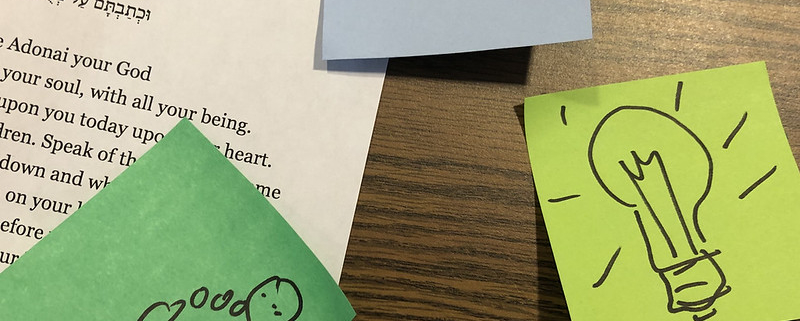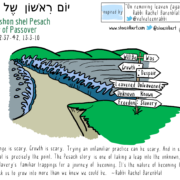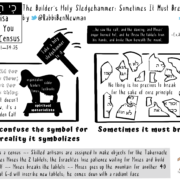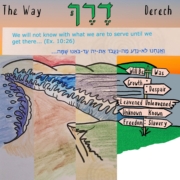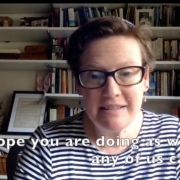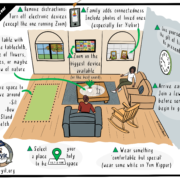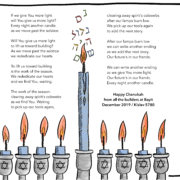Bringing Sketchnoting to the B-Mitzvah Classroom
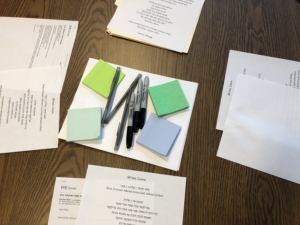 The first time Steve Silbert sketchnoted one of my divrei Torah, I was enthralled. The things he chose to highlight showed me what he found interesting in what I had written. His images uplifted my ideas in a new way. His sketchnote, rooted in my d’var Torah, was also its own piece of Torah creativity. That first sketchnote was my introduction to the spiritual technology of Visual Torah, now one of the tools Bayit offers for building Jewish life and practice.
The first time Steve Silbert sketchnoted one of my divrei Torah, I was enthralled. The things he chose to highlight showed me what he found interesting in what I had written. His images uplifted my ideas in a new way. His sketchnote, rooted in my d’var Torah, was also its own piece of Torah creativity. That first sketchnote was my introduction to the spiritual technology of Visual Torah, now one of the tools Bayit offers for building Jewish life and practice.
In 2019 Steve came to Bayit’s rabbinic innovation retreat to teach the art and spiritual practice of Jewish sketchnoting to a denominationally diverse group of rabbis, most of whom insisted that we couldn’t draw. Steve taught us that sketchnoting is about ideas, not art, and that anyone can do it: even us. By the end of that session, all of us had taken a crack at sketchnoting… and I had a vision of using sketchnoting to uplift my Hebrew school teaching. This year, I invited Steve to join my b-mitzvah class remotely, to teach the basics of sketchnoting to my students.
-
Educating the Educator
The first step in bringing sketchnoting and Visual Torah to my b-mitzvah classroom was the workshop that Steve led at Bayit’s rabbinic innovation retreat. Because I had that experience of learning to use sketchnoting myself, and also because I’d spent a year watching Steve create Visual Torah for a full cycle of parshanut blog posts for Builders Blog, I had some understanding of sketchnoting and Visual Torah as both spiritual practice and learning tool.
For anyone else who wants to bring Steve and this practice into your Hebrew school classrooms, I would strongly recommend some one-on-one sketchnoting learning with Steve first. Especially if he’s in the room remotely / via videoconference (as was the case here), it’s important that he have a hands-on partner in the room who understands sketchnoting both spiritually and pedagogically.
-
The Runway
The week before his visit, I asked my students and their parents to reread the Shema and V’ahavta and to make a list of five things in that prayer that they thought were important.
Each Monday I email my b-mitzvah parents to let them know what we’ll be learning that day. On the day when Steve was going to visit our class, I explained to parents that a digital visitor would be introducing sketchnoting, a spiritual technology designed to give their kids a new way of engaging with Torah and a new way of engraving their learning on their minds and hearts.
-
The Classroom Visit
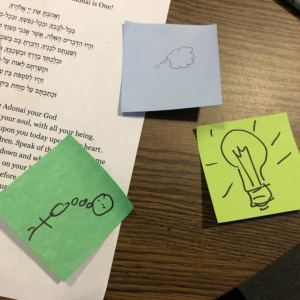 My students seemed bemused at having a guest teacher appear on my computer, but they got used to it quickly, and treated Steve as though he were sitting at our table.
My students seemed bemused at having a guest teacher appear on my computer, but they got used to it quickly, and treated Steve as though he were sitting at our table.
First Steve took us through a visual vocabulary exercise. Each student had a pad of Post-It notes and a Sharpie marker. “Draw what comes to mind when I say the word ‘idea,’” he told us. “Don’t overthink it, you have ten seconds, go.” Most of us drew lightbulbs. One person drew a thought bubble. (Almost everyone chooses one of those two images for that word, Steve told us.)
“Okay, now draw ‘house.’” We drew little boxes with triangular roofs and maybe a door and a window. “Draw ‘love.’” We drew hearts. Each time we tore off our post-it notes and stuck them to the whiteboard, we noticed that we had drawn variations on the same theme. Though none of us consider ourselves artists, we share some basic visual vocabulary. We have simple pictographs in mind for basic words — door, hat, flower — and we can convey those in images.
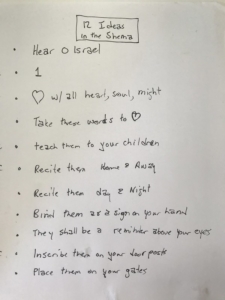 Then Steve gave us a set of Jewish prompts: mezuzah, Torah, hamentaschen, Ten Commandments, Shabbat candles. It turns out that we have shared visual vocabulary there too.
Then Steve gave us a set of Jewish prompts: mezuzah, Torah, hamentaschen, Ten Commandments, Shabbat candles. It turns out that we have shared visual vocabulary there too.
And then we moved into the Shema and V’ahavta. We talked through the lists of five things that each student had considered “core” in that prayer. Some ideas were common across everyone’s list and others were more individual.
Still working with post-its, we took a crack at drawing each of the five items on our lists. And then we placed them on a page, with the shema in the center and the five ideas circling around it like spokes on a wheel. Because we were working with post-it notes, we could rearrange our items at will.
By the end of the class, each student had a draft of a sketchnote exploring the core ideas of the Shema and V’ahavta.
-
Re-Inscribing
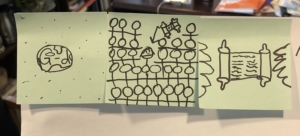 A few weeks later, when we returned from winter break, we re-inscribed our sketchnote learning. I took the students through the basic visual vocabulary and basic Jewish visual vocabulary exercises again, to remind them that this is something they can do.
A few weeks later, when we returned from winter break, we re-inscribed our sketchnote learning. I took the students through the basic visual vocabulary and basic Jewish visual vocabulary exercises again, to remind them that this is something they can do.
Then we engaged in the same sort of exercise with the blessings before and after an aliyah of Torah. Questions that came up included: how might we depict God on a Post-It note? How about chosenness? “From among” all peoples or “along with” all peoples? And then each student arranged their Post-It notes to create a sketchnote of that prayer.
-
Did it “work”? (Yes.)
The sketchnoting lesson with Steve kept my students active and engaged. In that sense it was an immediate success.
A few weeks later, I asked students what had stayed with them about studying the Torah blessings. They volunteered the images they had drawn. Having put pen to Post-it, they retained the core ideas they had depicted.
Studies have shown that writing or drawing something by hand inscribes it on the brain in a different way than reading it or even typing it. Sketchnoting these prayers gave my students an opportunity to engage using a different part of the brain than usual. And translating these prayers into images and rendering them with their own pens gave my students a different sense of ownership than just learning to read or sing them. (As one student said, “now that I put it on a Post-It, it’ll really ‘stick’ with me!” And that has turned out to be true.)
Based on the success of these experiments, I have other sketchnoting plans. We’ll sketchnote mitzvot, spiritual practices, the b-mitzvah journey. Based on what I saw in my classroom, I’m certain that Visual Torah and sketchnoting deepened my students’ engagement with the tradition. I can’t measure “how much” it impacted them, but I can see that it did. I’m excited to see what will flow next from their pens.
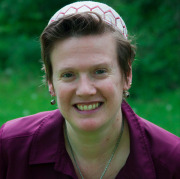

by Rabbi Rachel Barenblat with Steve Silbert.

